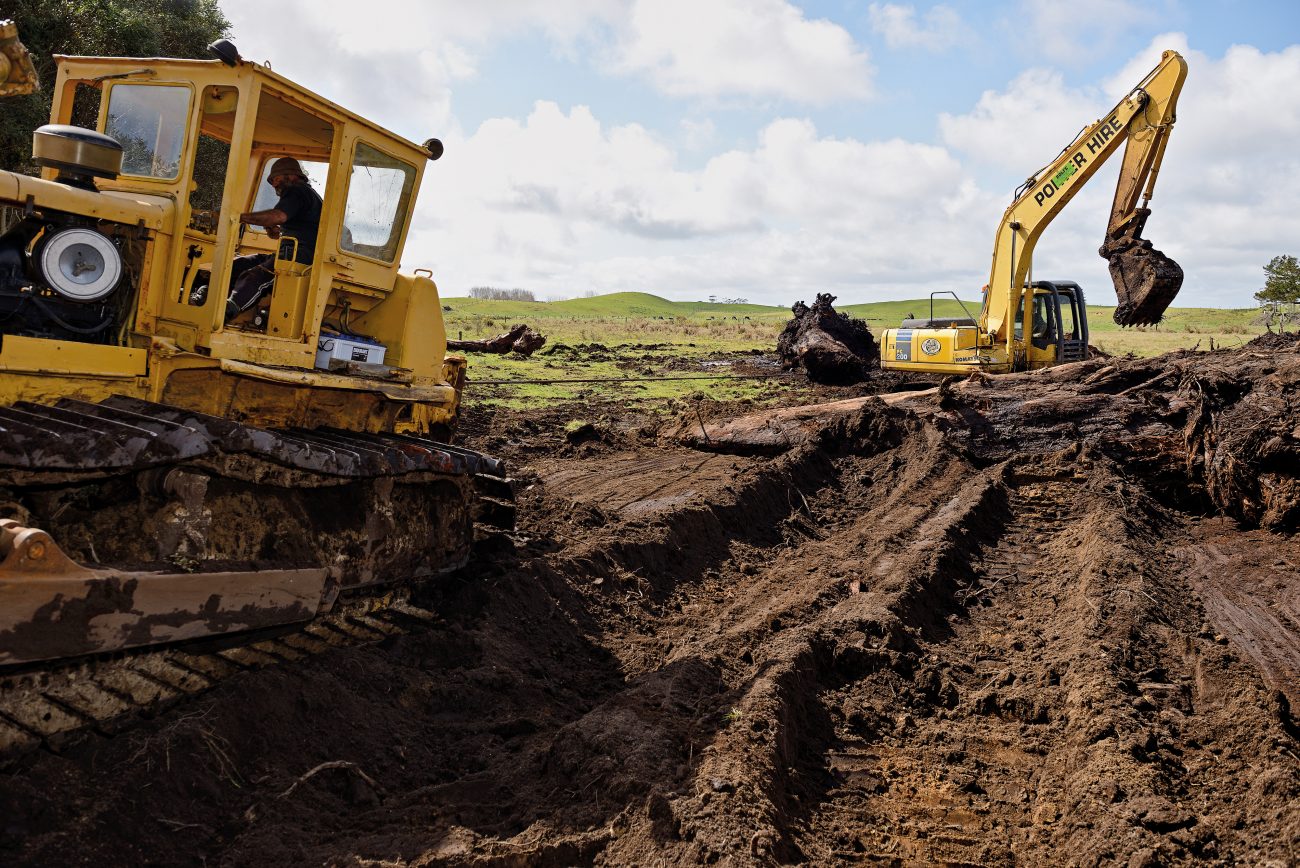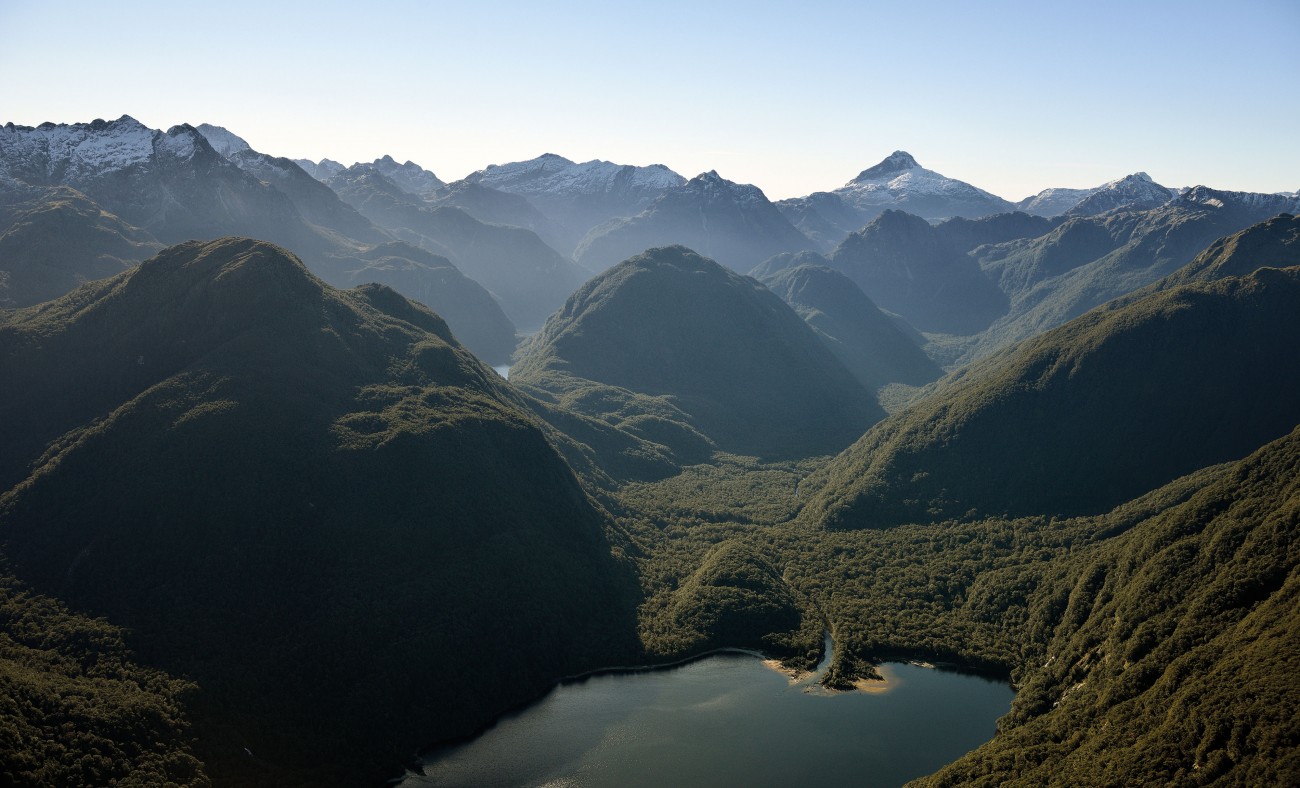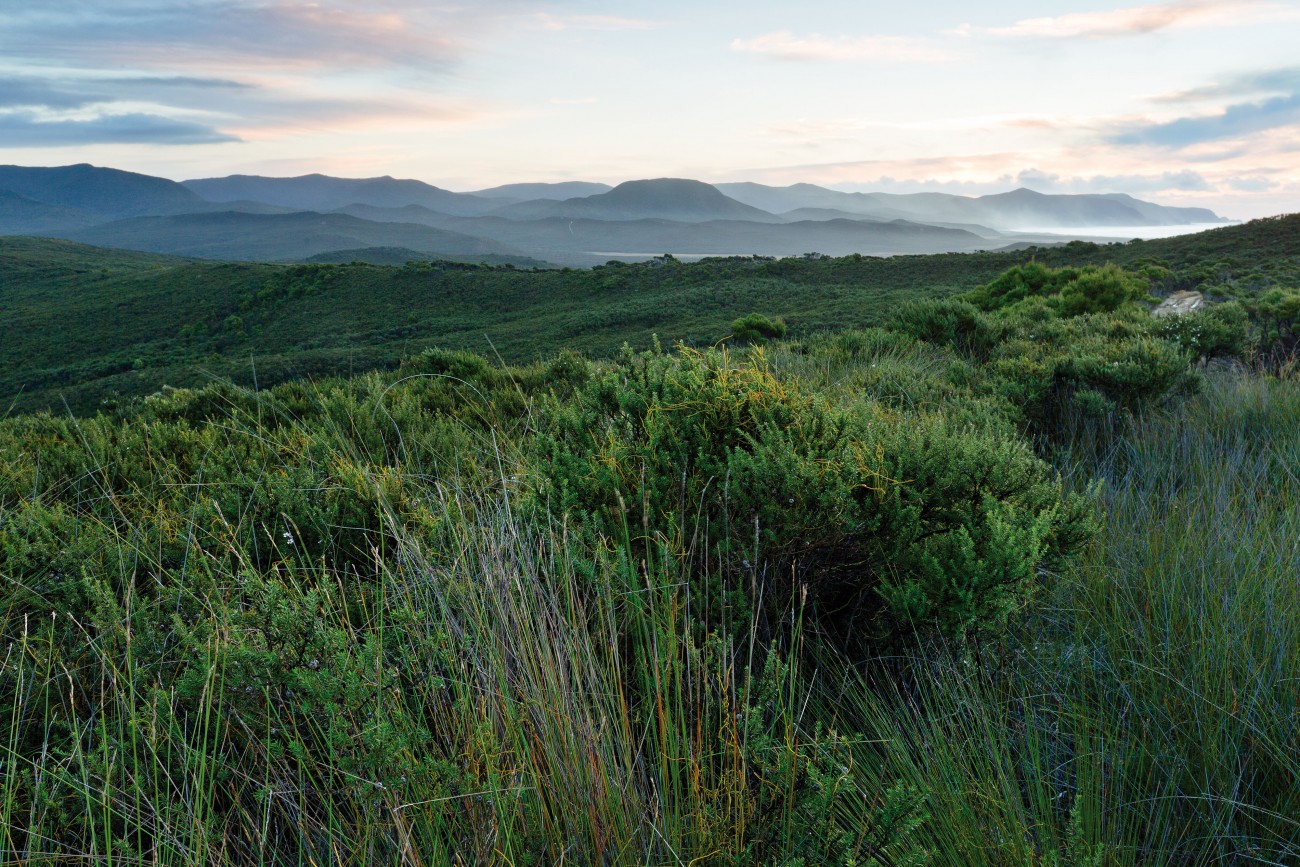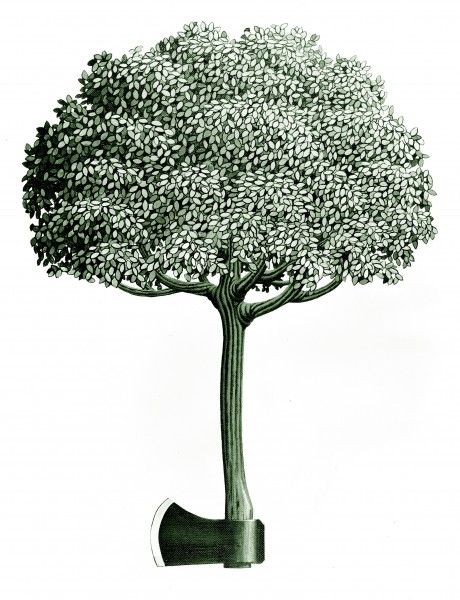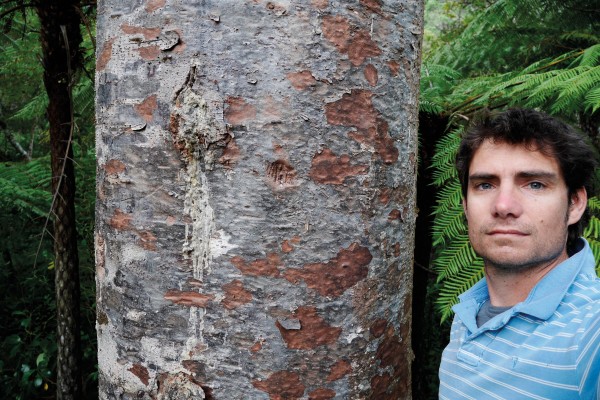
Forest giants
Kauri are among the most magnificent trees on Earth. Yet they have been subject catastrophic logging in the 19th and 20th centuries, and in the 21st, a more pernicious threat that creeps through the soil itself. There is no cure for Phytophthora agathidicida, which leaves kauri bleeding sap until the tree perishes. How will we save the last of our giants?
The last of the giants
Kauri create shelter and nourishment for other species to grow, but now, a disease without a cure is killing these forest giants one by one. In the past five years, the infection rate of kauri has more than doubled in the only forest where it's monitores—the Waitakere Ranges. At least one in five trees there are doomed. Can we save the species?
Buried treasure
Submerged for aeons in the peat bogs of New Zealand’s north, swamp kauri is one of the world’s most valuable and exquisite timbers, and an unparalleled resource for global climate science. But as exports boomed and wetlands were ruined in the rush for the logs, the swamps have become an ideological battleground. What is the future of this ancient taonga?
Temple poles and taonga
Every other week I go for a long run through bush close to our house in the Auckland suburb of Birkenhead. Much of it is dominated by towering macrocarpas, but as I scramble up the trail that runs along the edge of Duck Creek, the thin understorey of ponga becomes more dense and diverse, the natives become larger, and at the head of a valley in the comparatively new suburb of Chatswood, I find myself surrounded by giants.
Four kauri form a copse, rising like Apollo rockets from the undergrowth. I can get my arms about half way around the trunks of three of them, the other, not even close.
I lean back on a perfunctory wooden seat and stare upward, the trees tilting toward a common vanishing point high above. Tūī clatter and whirr through the canopy.
A core sample taken by University of Canterbury researcher Dave Norton suggests that the largest—1.7 metres in diameter—is about 475 years old. That’s not particularly old as large kauri go, but it pre-dates the arrival of Tasman by a century. It stood here throughout the tumultuous period of European settlement, and survived the kauri timber industry that enabled the construction of the colony. While its brethren were felled to provide the weatherboards and floors for my house, built some time before 1900, the Armed Constabulary were sacking Parihaka—a story of injustice barely mentioned in the public history of this country, but now recounted in detail in this issue.
But these trees can do better than stand mute in the presence of history; they are living barographs of natural events, as Kate Evans investigates in her feature ‘Buried Treasure’. Ancient kauri provide a continuous climate record back 4500 years, and a more disconnected record back to the limit of radiocarbon dating 60,000 years ago.
Ironically, the science benefits directly from the commercial extraction of swamp kauri, a resource being exported as ‘tabletops’ and ‘temple poles’ to international buyers, echoing the complex politics that has divided Northland. Is swamp kauri worth more in the ground or out of it? Are our remnant forests more valuable dead or alive? How do we begin to value these things when our sense of value is coloured so greatly by our perspective?
This is the same question posed by ecologist Jamie Steer, profiled on page 28, who is being accused of conservation heresy. His suggestion that introduced species are as valuable and relevant a part of our ecosystem as natives has raised the ire of those whose focus is on eradicating them. He’s not committing scientific treason, he says, simply forwarding an opinion that “opens up the conversation”.
What can we learn from controversial conservation ideas? What can we learn from logs buried for aeons in metres of peat? What can we learn from the long-obscured story of Parihaka?
For Andrew Judd, former mayor of Taranaki, learning about the events at Parihaka was life-changing. When he was elected, he had “no knowledge of the Treaty, no true knowledge of our past, no understanding or empathy towards Māori. I was wrong, I was ignorant and arrogant,” he said in a candid interview on RNZ recently.
New Zealanders pay lip service to the Treaty and are blind to its privilege, he said. “We do a haka at a rugby match, we sing the national anthem in both languages and think we’ve hit the mark . . . It’s archaic, and it has to change, because it’s not working.”
New perspective is powerful. It can recalibrate one’s sense of reality, even reset the course of a nation. Like Judd, facing history’s inconvenient truths, acknowledging nature’s evolving complexity, reconciling the relative values of temple poles and taonga are among those difficult processes that are tempting to ignore, but in addressing them we will start a new and enlightening conversation for everyone.
The future of our forests
Native forest once covered most of Aotearoa in a great green swathe, heaving with biodiversity. Two-thirds fell to fire, axe and bulldozer during a botanical Blitzkrieg the like of which the world has never seen. Today’s forest remnants are confined largely to areas of conservation land, but legislation can’t protect against pathogens, pests and invasive weeds that do not respect park boundaries. What does the future hold for our forests?
Northland's buried treasure
"Gold fever" struck northern New Zealand in the late 1800s, and peaked at the turn of this century with 20,000 fortune-hunters spread across some 800,000 acres of land. What they were seeking was not metallic gold, but kauri gum: a rich golden resin which polishes up like glass and is one of this country's most beautiful natural products.
Managing kauri dieback disease
Kauri dieback is a serious disease that kills Kauri trees. It's decimating kauri forests in northern New Zealand, and is partiucalrly severe in the popular Waitakere Ranges in West Auckland. The public is once again being called upon to help fight the spread of the disease, and getting those messages out is the task of Dr Nick Waipara, Principal Advisor for Biosecurity for Auckland Council.
Talking with trees
“We must talk again with trees,” wrote West Coast poet Peter Hooper.
We must talk with them because we are apt to forget they are living beings. We think of them as timber sources and landscape features. Or as obstructions that stand in the way of a subdivision or block the kilometre-wide sweep of a centre-pivot irrigator... if we think of them at all.
Despite this having been once a country of forests, there is no tree on the New Zealand coat of arms. There are a couple of fern fronds, but a cartoon Maori warrior and Pakeha woman are standing on them, like a mat (which is not a bad metaphor for how native vegetation has been treated in the past 150 years).
Aotearoa was a land of giant trees as much as it was of giant birds. In both cases kauri and moa they were among the largest ever known. In the north, there is a story that the kauri tree has an oceanic twin, the sperm whale. It is an intriguing link, drawing on the fact that both produce resin ambergris in the sperm whale and the skin of both flakes off in thick slabs. And the size, of course. Imagine you’d stepped off a waka after crossing the Pacific, serenaded by singing whales, and were confronted with a six- or seven-metre-diameter kauri trunk. What would come to mind?
Kauri are the rangatira tree of the north, but south of their natural range (which cuts off around the latitude of Raglan), that chiefly role is taken up by totara. During my travels for the forests story in this issue, I visited one of the rakau rangatira of Pureora State Forest. It has a name the Pouakani totara signposted on the main road.
I parked and took the 20-minute walk to the tree, on a track that weaved through agreeably dense bush. Halfway along, I paused beside a fallen totara log to inspect a pile of wine-red shavings, the work of chewing insects and other agents of decay, rendering the trunk into nurture for life underground. About the time I thought I must be close, I glanced to the right of the track and thought for a moment I was seeing an outcrop of rock. Then my knees went weak and something buckled within me.
According to Greek history, the Persian king Xerxes the Great once saw a majestic plane tree during the course of a military march. He halted his army and ordered that they set up camp around the tree so that he could admire it. The historian Aelian recorded that Xerxes “attached to it expensive ornaments, paying homage to the branches with necklaces and bracelets. He left a caretaker for it, like a guard to provide security, as if it were a woman he loved.”
That is how you respond to a chiefly tree!
I walked around a fence that had been erected to protect the totara and looked up into its plant-drenched canopy. This tree began its life 1800 years ago, around the time that Taupo erupted and flattened the central North Island. This tree precedes all human life in Aotearoa.
Yet totara is the timber that Europeans dignified by turning it into window sashes, doorstops, foundation piles and fenceposts. From today’s perspective, it seems as lamentable as using Chateau Lafite in a stir-fry. How the Pouakani totara escaped the chainsaw, I do not know. But had protesters not taken to the Pureora treetops in 1978, all this would surely be gone.
The illustrious ornithologist Charles Fleming said New Zealand’s podocarp remnants are this nation’s Gothic cathedrals, and standing in the presence of a tree like the Pouakani totara is an inescapably numinous experience.
The ancients understood this. Pliny the Elder wrote:
“As much as we adore the statues of the gods, with their brilliant gold and ivory, we revere the forests, and the silences within them.”
In Maori understanding, trees are part of the human family tree: they are our elder siblings. Tane, they say, made trees before making humans a story not dissimilar to the first chapter of Genesis, or to the unravelling of the human genome, which shows we share a third of our genes with oak trees.
It is said you can’t know who you are until you know where you are. Kentucky farmer and essayist Wendell Berry wrote: “Until we understand what the land is, we are at odds with everything we touch. And to come to that understanding...we have to re-enter the woods.”
We must talk again with trees.
A malevolent microbe
Phytophthora Taxon Agathis (PTA) is a microbe that attacks kauri, damaging the tissues that are the pathways of nutrients through the trees. It passes through the soil from tree to tree at the rate of a few metres a year, or is moved in soil borne on boots, tyres and equipment. There is no known cure and nearly all affected trees die as a result.
The disease is now widespread in Northland, Auckland and on Great Barrier Island, but news in March that it had been found in two trees in Whangapoua Forest on the Coromandel Peninsula sparked alarm among ecologists. The slow-moving pathogen had travelled nearly 200 kilometres into a little-frequented forest that hosts one of the largest areas of kauri still unaffected by the disease.
The Ministry for Primary Industries and Department of Conservation closed the 319-hectare forest, and in May the government announced a $25 million budget to fight Phytophthora. But the disease may be more widely distributed than anyone appreciates.
On a weekend in June I travelled to a friend’s 40th birthday at a house tucked into the bush overlooking Pauanui. The property borders a conservation reserve, so we went for a ramble with the kids in the evening up a narrow four-wheel-drive track. The bush there is a mix of established natives with wilding pines blown in from neighbouring tracts of plantation forests. In many respects, the Pauanui Conservation Area is typical of mixed-use, public-access estates in the North Island and too well trafficked to avoid the invasion of weeds, and disease.
The first kauri I saw, a little ricker barely four metres high, oozed a plume of sap from a bulging lesion on its trunk. The resin was coagulated in thick ribbons that ran down to the soil like a limestone formation, and beneath the wound, the bark had sloughed away in sheets. Am I looking at Phytophthora taxon Agathis? It hadn’t been reported as far south as Pauanui, nor within 50 kilometres of here, and only two trees in Coromandel had so far tested positive. Yet the notion that this quiet killer can reach kauri forests anywhere makes the spectre of sap disconcerting. (I deferred to MPI to investigate.)
Directly across the track was a larger specimen, too wide in girth to stretch my arms around, and perhaps 30 metres high. The track bent about it in deprecating fashion. It may have been here for a hundred years or more, avoiding both fire and axe, but the quiet malevolence of PTA is creeping toward it even now if it hasn’t already hitched a ride on a tyre of a passing 4x4, or upon the boots of this editor, who stood at its base to admire the undulating surface of the trunk, rippled like sand at low tide.
It is astonishing that an organism just microns in dimension can lay low a forest giant. It’s a cautionary tale.
Like the social and industrial ideology that set two-thirds of New Zealand’s forests to fire and axe, Phytophthora flows through the land like a destructive idea through a population it’s ubiquitous, and once started, it’s not easily stopped.
Have we already come too far to turn back? It may be too early to tell. The bacterium that caused the death of about a quarter of the cabbage trees in the north at the turn of this century seems to be less severe now. In that case, our understanding of the disease grew as the pathogen spread it affected different sized tree in different ways; trees in rural settings were more susceptible than those in forests; and those growing in cooler climates were less affected than those in the north.
Kauri dieback may yet be averted by good management or good fortune, but it is certain that as international trade grows and domestic traffic increases, the forests of our future will face more of these insidious threats, and need greater protection.







